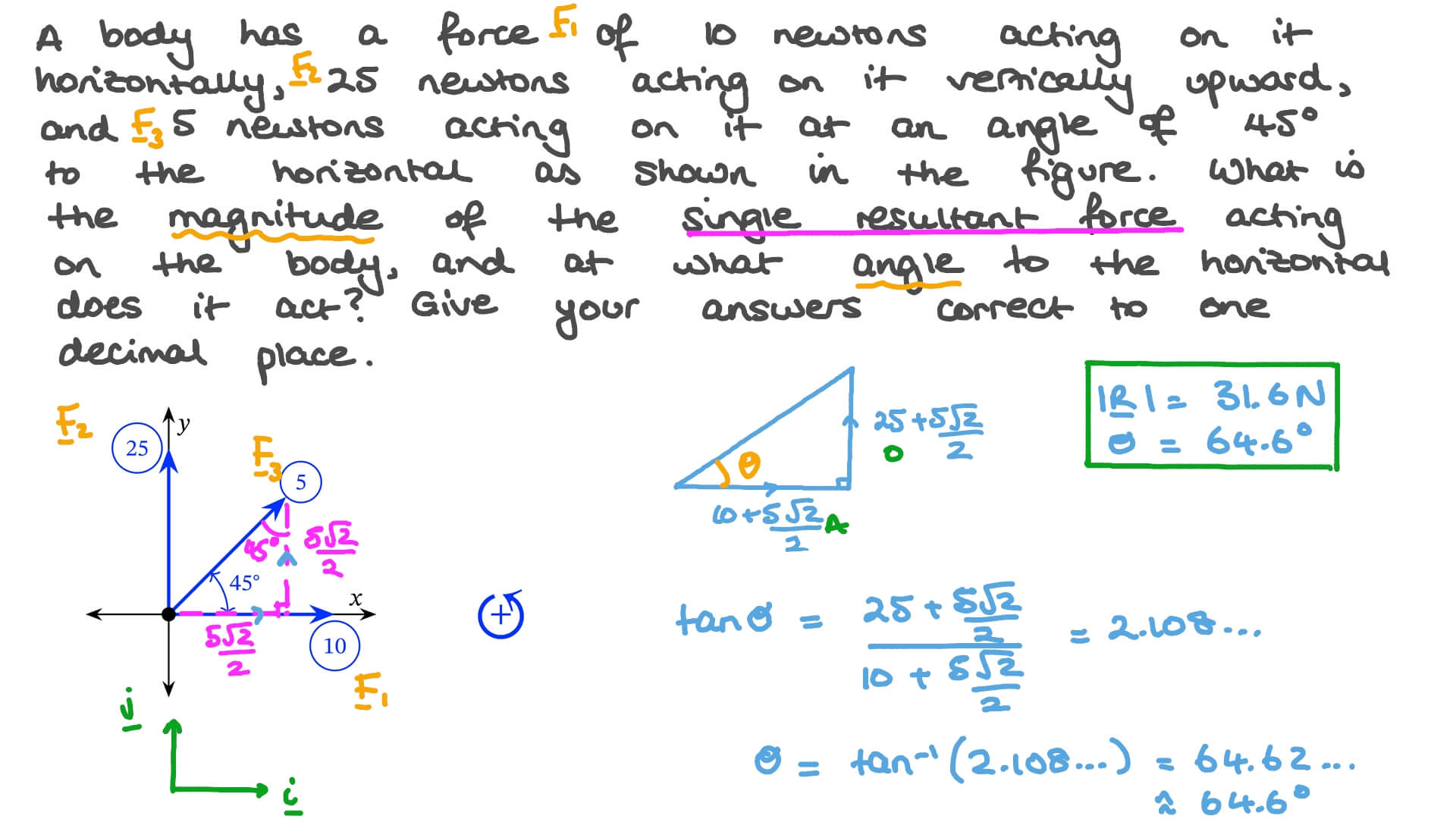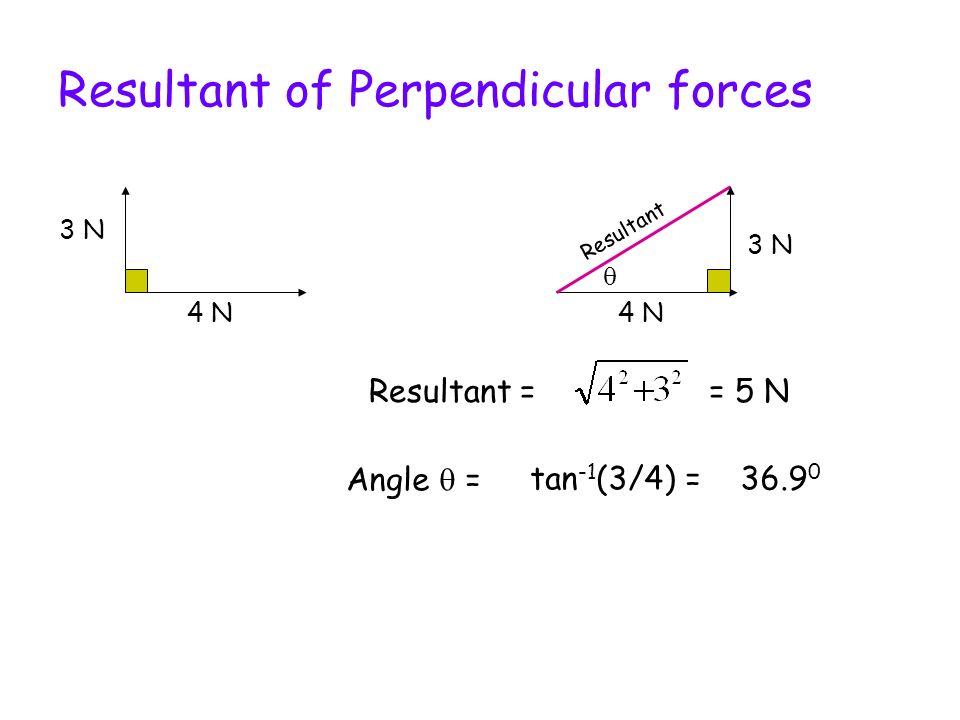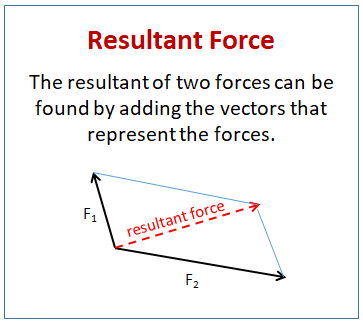Resultant Of Angle Formula
We calculate the resultant force and angle of three vectors a fundamental principle for any engineerTimeStamp 107 - First step -Calculating the forces in. The resultant force can be obtained by using parallelogram law of vectors.

Two Forces 3n And 4n Are Acting Perpendicular To Each Other What Is The Magnitude Of The Resultant Force And How Quora
The resultant vector formula is large overrightarrowRsqrtoverrightarrowx2overrightarrowy2 Solved Example.

Resultant of angle formula. D sin-1 sin2 A sin2 B12 For example if A 5 and B 15 then C is 714 in plan view with the front of the object at the bottom and 0 being due east and D is 158. This video shows how to find the magnitude and angle of the resultant force given the magnitude and angle between two vectors. Substituting this in equation 1 OC 2 OA 2 2 OAAD AC 2 2 If is the angle between the two vectors then AOB But DAC AOB .
As example lets take the force system from Exercise 1 and calculate the resultant force and its angle with the horizontal axis O-x. Substituting this value in equation 2 OC 2 OA 2 2 OAAC cos AC 2. For a case like this we use the formula that will square root of the sum of squares of each vector.
Finding resultant force using vector scale diagrams for GCSE Physics 9-1 About Press Copyright Contact us Creators Advertise Developers Terms Privacy Policy Safety How YouTube works Test. The Resultant force formula is given by Where are the forces acting in the same direction on a body. In the ACD AD AC cos .
Use the cosine law to find the length of the side opposite the 120 degree angle the magnitude of the resultant vector and then use the sine law to find the angle that side makes with one of the others. The following formula is used to calculate the resultant vector from the summation of two different vectors. The forces and angles are as follows.
C tan-1 sin B sin A And the resultant angle D the angle of the leg or spindle in its own plane is. To express the direction of R we need to calculate the direction angle ie. But OC R OA P and AC OB Q.
F 1 291 N 1 0 F 2 267 N 2 60 F 3 247 N 3 150 F 4 223 N 4 270. Find the angle between the tail of the hypotenuse and the adjacent vector. But the sum of the forces taken as vectors which is much suitable.
Calculate the resultant vector if overrightarrowx4 and overrightarrowy 5. Direction Angle Of Resultant Force tan-1 5 x sin20 8 x sin255 x cos20 8 x cos25 23 The direction angle of resultant force is calculated from the resultant of two forces acting at an angle. The magnitude of the resultant is solved using the law of sines which in formula form is written as a sin A b sin B c sin C Solving for Angle A b sin 53 a sin A.
The net force has a magnitude of 17 N using Pythagoras theorem. If is perpendicular to then the resultant force formula is given as. Find magnitude of the resultant force using the new vector equation and the distance.
R 2 P 2 2 PQ cos Q 2. For this method to work all angles need to be referenced to the horizontal axis O-x. In this video we will cover Magnitude Resultant and Direction of two vectors Special cases about resultant and direction and solved examplesTypes of v.
The counterclockwise angle that R makes with the positive x-axis which in our case is 180 ie. The process that we used in this case and in the previous one to find the resultant force when the forces are not parallel can also be used when all the forces are parallel. X x -axis.
To find the magnitude and angle of a resultant force we create vector equations for each of the given forces add the vector equations together to get the vector equation of the resultant force find magnitude of the resultant force using the new vector equation and the distance formula. Resultant of two forces acting on a particle with an angle Formula resultant sqrtFirst Force2 2First ForceSecond forcecosAngle between two forcesSecond force2 R sqrtF12 2F1F2cosF22. This is the direction of the resultant vector.
Notice that this is not merely the sum of the magnitudes of the forces. It is directed at an angle tan 1 15 8 with the force of 8 N. Do you remember the mnemonic device SOH-CAH-TOA you used in.

Newton S Laws S4 Physics Revision

Two Vectors Having Equal Magnitude Of 5 Units Have An Angle Scholr

Magnitude And Angle Of The Resultant Force Kristakingmath Youtube

How To Find The Resultant Of Two Vectors Youtube

Find The Resultant Force And Its Direction Angles Youtube

Find The Resultant Force And Its Direction Angles Youtube

How To Show That The Resultant Of Two Equal Vectors Bisects The Angle Between The Vectors Quora

Lesson 1 Vector Addition Numerical

Question Video Finding The Magnitude And Direction Of The Resultant Force Of Three Forces Acting On A Body Nagwa

Vector Application Find Magnitude And Angle Of The Resultant Force Youtube

Resultant Of Two Forces Ppt Video Online Download

The Resultant Of Two Forces Solutions Examples Videos Worksheets Games Activities

The Resultant Of Two Vectors Makes An Angle Of 60 With One Vector And 30 With One Other If The Magnitude Of Resultant Is 25 The Two Vectors Are Of Magnitude

The Resultant Of Two Forces Solutions Examples Videos Worksheets Games Activities

Find The Resultant Force And Its Direction Angles Youtube

Vector Application Find Magnitude And Angle Of The Resultant Force Youtube
What Is The Resultant Force When The Two Forces Act At Angles To Each Other Degrees 60 One Force Acting With Force Of 3n And One With A Force Of 4n Quora

Question Video Finding The Resultant Of Two Vectors Using The Parallelogram Method Nagwa

Finding Resultant Force From 2 Forces At 0 To 90 Degree Physics And Mathematics 90 Degrees Physics
Posting Komentar untuk "Resultant Of Angle Formula"